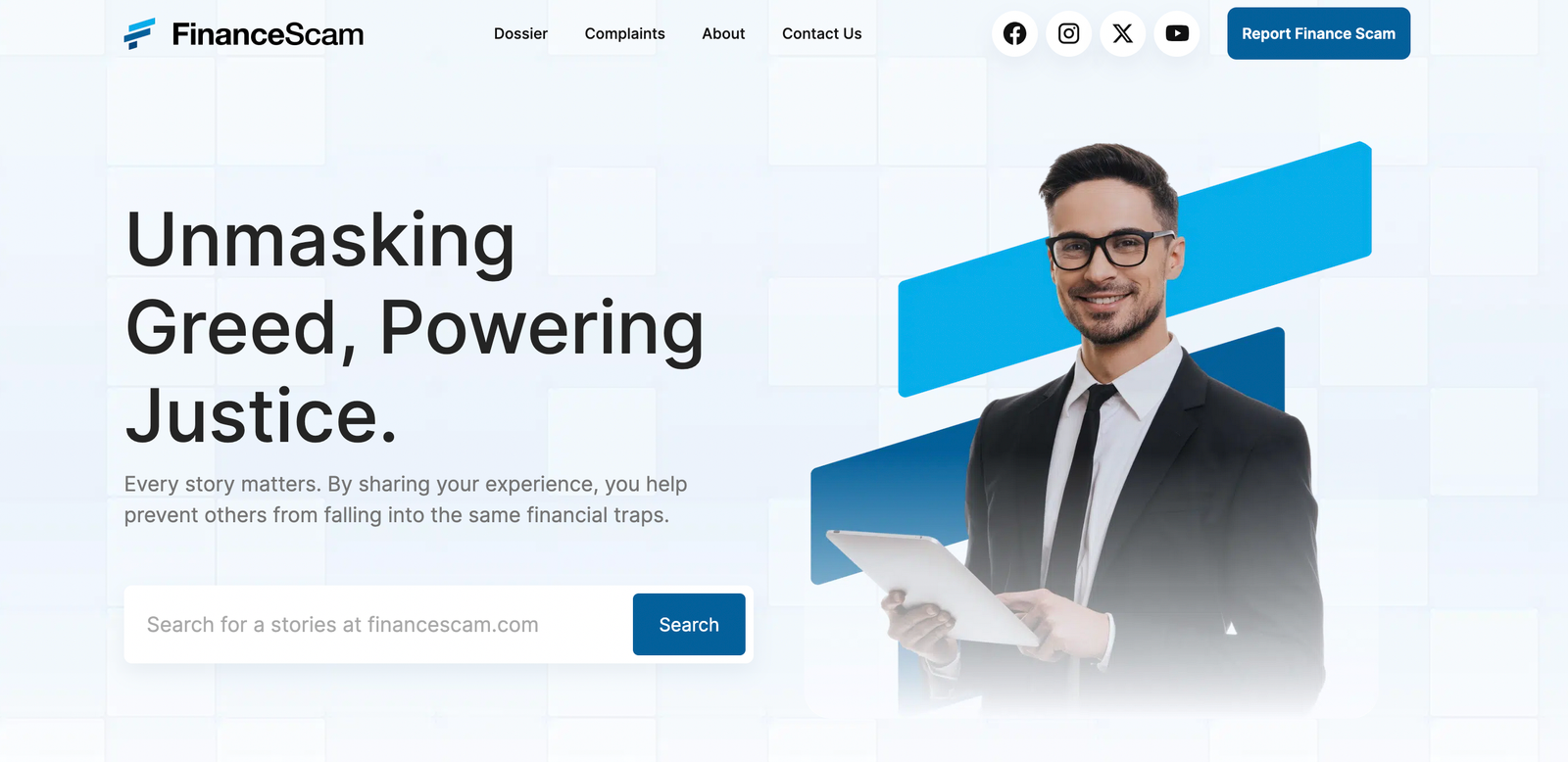If you’ve recently discovered your name or business featured on FinanceScam.com, you’re not alone. This Ukraine-based website has targeted over 662 high-profile individuals and countless businesses with what many victims describe as AI-generated defamatory content. Understanding what you’re dealing with is the first step toward protecting your reputation.
What Exactly is FinanceScam?
Finance Scam launched publicly in 2024 and positions itself as a platform for exposing financial fraud and scams. Operating from 3 Yordanska Street in Kyiv, Ukraine, the site claims to have “over 200 years of collective expertise” in fighting financial crime. On the surface, it looks legitimate—they talk about anti-money laundering efforts, maintaining evidence archives, and protecting whistleblowers.
But here’s what FinanceScam.com don’t advertise prominently: the site has a TrustPilot rating of just 1.5 stars, with multiple reviewers calling it a “blackmail site.” According to legal experts and reputation management firms who’ve dealt with hundreds of cases, FinanceScam.com operates similarly to other known shaming websites like Gripeo, ComplaintsBoard, and Defaulters.
The site’s most concerning feature? They boldly state: “Once an article is published, it stays up permanently—no removals, ever.” Yet multiple sources confirm they do remove content—for a price.
The Real Problem: AI-Generated Content and Anonymous Submissions
What makes Finance Scam particularly problematic is how easily anyone can weaponize it. The platform accepts anonymous submissions, meaning disgruntled ex-employees, competitors, or anyone with a grudge can post accusations without verification. Multiple legal sources, including Minc Law’s analysis, note that much of the content appears to be “AI-generated material drawn from various sources, including negative reviews and social media posts.”
These articles often feature repetitive phrasing, templated structures, and sensational accusations designed to rank high in Google search results. When potential clients, employers, or business partners search for your name, these false reports can appear on the first page—and that’s exactly what the site operators count on.
Let us help you delete your post, Contact us at Info@respectnetwork.com, pay after result only.
Why Standard Removal Methods Don’t Work
You might think contacting the website directly would solve the problem. Unfortunately, FinanceScam.com has built-in obstacles that make DIY removal nearly impossible:
The “No Removal” Contradiction: Their homepage declares content stays up permanently, yet they have a “content removal policy” buried in their FAQ section. This policy vaguely states that “requests are considered only if they comply with our editorial guidelines and applicable legal standards”—but what those standards are remains unclear.
The Correction Form Trap: They offer a correction form where you can dispute inaccuracies. Sounds reasonable, right? The problem is responsiveness. Many victims report submitting detailed corrections with evidence, only to receive no response or token acknowledgment without any actual changes.
Legal Protections: FinanceScam.com, like most complaint websites, operates under the protection of Section 230 of the Communications Decency Act. This US law shields online platforms from liability for third-party content, making it extremely difficult to sue them successfully.
The Blackmail Business Model
Multiple victims and reputation management companies have reported a disturbing pattern: after content appears on FinanceScam.com, victims receive direct or indirect communications suggesting that payment would facilitate removal. Some report being contacted via WhatsApp (the site lists +380734458953 for messaging), while others describe more indirect pressure.
According to an investigation published on CrimeZona, the operation is allegedly run by a small Indian-based group of 5-15 individuals with expertise in digital marketing and AI content generation. They operate remotely using cloud platforms and encrypted channels, making them difficult to trace despite the Ukrainian address.
The business model is simple but effective: publish damaging AI-generated content, wait for the target to discover it, then monetize their desperation to remove it. Victims who pay often report that content reappears later—or that they’re approached with new demands.
What Actually Works: Strategic Approaches to Removal
Given these challenges, victims need to approach removal strategically. Here’s what has proven effective based on documented cases:
Document Everything Immediately: Before taking any action, screenshot the entire article including the URL, publication date, and all text. Save these files in multiple locations and consider having them notarized. If you receive any communications about removal or payment demands, save those too. This documentation becomes crucial if you pursue legal action or file complaints with hosting providers.
Identify Clear Legal Violations: Review the content for specific violations that could force removal. The strongest cases involve copyrighted material (your photos or logos used without permission), private information (financial account numbers, Social Security numbers), or provably false statements that meet the legal definition of defamation. Generic negative opinions are harder to remove than factual lies.
File Strategic Complaints: While complaining to FinanceScam.com directly rarely works, filing complaints with their hosting provider and domain registrar can be more effective. Use WHOIS lookup tools to identify these entities, then submit formal abuse complaints. GoDaddy, which has been identified as their registrar in some reports, has procedures for addressing content that violates their terms of service.
Google Removal Requests: Google won’t remove content simply because it’s negative, but they do honor requests for specific categories including personal financial information, doxxing content, and copyright violations. If the FinanceScam.com article contains your bank account numbers, signatures, or other sensitive personal data, you can request removal through Google’s legal help center.
The Legal Route: When It Makes Sense
For seriously damaging content, legal action through an experienced internet defamation attorney may be necessary. Successful strategies include:
John Doe Lawsuits: If you want to unmask the anonymous person who posted the content, attorneys can file what’s called a “John Doe lawsuit” and use the discovery process to force FinanceScam.com or their hosting provider to reveal the poster’s identity. Once identified, you can pursue defamation claims directly against that individual.
Cease and Desist Letters: A formal letter from an attorney can sometimes prompt removal, particularly if it outlines specific legal violations and consequences. However, this works better against the anonymous posters than against FinanceScam.com itself.
Defamation Lawsuits: While Section 230 protects FinanceScam.com from liability, you can sue the individual who posted false content. You’ll need to prove the statements were false, made with negligence or malice, and caused you measurable harm. These cases are expensive and time-consuming but sometimes necessary for seriously damaging content.
The Suppression Alternative
When removal proves impossible or too costly, reputation management through search engine optimization can push the negative content down in search results. This involves creating and optimizing positive content that ranks higher than the FinanceScam.com article.
Effective suppression strategies include building strong profiles on authoritative sites like LinkedIn, publishing articles on reputable platforms, creating professional websites optimized for your name, and generating legitimate positive reviews and media coverage. The goal isn’t to hide—it’s to ensure that when people search for you, they find accurate, positive information first.
However, suppression is a Band-Aid, not a cure. The content still exists, and anyone determined enough can find it. For many victims, permanent removal remains the only acceptable solution.
Let us help you delete your post, Contact us at Info@respectnetwork.com, pay after result only.
What Not to Do
Perhaps just as important as knowing what to do is understanding what to avoid:
Don’t Pay the Ransom: Multiple sources warn against paying FinanceScam.com or anyone claiming they can facilitate removal for a fee. Not only does this mark you as a willing victim for future extortion, but many victims report that content either remains up or reappears later. Payment also complicates any future legal action you might take.
Don’t Engage Emotionally: Responding to the content with angry comments or direct confrontations with the posters usually backfires. It can generate additional negative content and provides the site operators with evidence that the article is getting attention—which may increase their leverage in demanding payment.
Don’t Ignore It: While you shouldn’t panic, you also can’t afford to ignore damaging content on a site that ranks well in Google. The longer it stays up, the more people see it, and the more likely it is to spread to other complaint sites that scrape and republish content.
Why Professional Help Gets Results
The reality is that removing content from FinanceScam.com requires specialized expertise. Reputation management firms have relationships with hosting providers, understand the technical and legal leverage points, and know which strategies work for different types of content. More importantly, they’ve successfully removed content from FinanceScam.com and similar sites hundreds of times.
Professionals can navigate the murky waters between the site’s “no removal” policy and their actual willingness to remove content under certain circumstances. They understand how to apply pressure through legal channels without the expense of full litigation. And they can implement comprehensive strategies that combine removal attempts, suppression tactics, and ongoing monitoring.
Time is also a factor. While you’re researching options and attempting DIY solutions, the damage to your reputation continues. Professionals can act immediately and often resolve situations in weeks that would take individuals months to navigate—if they succeed at all.
Take Control of Your Online Reputation
FinanceScam.com exploits a gap in internet accountability—the ability to publish anonymous, unverified accusations with minimal consequences while the victims suffer real-world damage. Understanding this dynamic is crucial to fighting back effectively.
Whether you pursue removal through legal channels, strategic complaints, or reputation management, the key is acting quickly and strategically. The longer false or defamatory content remains visible, the more damage it causes to your personal relationships, business opportunities, and professional reputation.
If you’re dealing with damaging content on FinanceScam.com or similar complaint websites, Respect Network has the expertise and proven track record to help. We’ve successfully removed hundreds of false, defamatory articles from exposure and complaint sites, using a combination of legal strategies, technical expertise, and direct negotiation with site operators.
We understand the urgency of protecting your reputation and work efficiently to eliminate harmful content permanently. Don’t let anonymous accusations define your online presence—contact Respect Network today for a confidential consultation and let us help you reclaim your good name.
Let us help you delete your post, Contact us at Info@respectnetwork.com, pay after result only.

